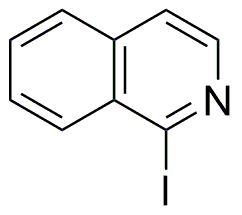1-Iodoisoquinoline is widely utilized in research focused on:
- Synthesis of Pharmaceuticals: This compound serves as a key intermediate in the synthesis of various pharmaceutical agents, particularly in the development of anti-cancer drugs.
- Organic Electronics: It is used in the fabrication of organic light-emitting diodes (OLEDs), enhancing the efficiency and performance of display technologies.
- Fluorescent Probes: Researchers employ it to create fluorescent probes for biological imaging, allowing for better visualization of cellular processes.
- Chemical Sensors: 1-Iodoisoquinoline is utilized in the development of chemical sensors, providing sensitive detection of environmental pollutants.
- Material Science: Its unique properties make it valuable in the creation of advanced materials, including polymers with specific electronic characteristics.
General Information
Properties
Safety and Regulations
Applications
1-Iodoisoquinoline is widely utilized in research focused on:
- Synthesis of Pharmaceuticals: This compound serves as a key intermediate in the synthesis of various pharmaceutical agents, particularly in the development of anti-cancer drugs.
- Organic Electronics: It is used in the fabrication of organic light-emitting diodes (OLEDs), enhancing the efficiency and performance of display technologies.
- Fluorescent Probes: Researchers employ it to create fluorescent probes for biological imaging, allowing for better visualization of cellular processes.
- Chemical Sensors: 1-Iodoisoquinoline is utilized in the development of chemical sensors, providing sensitive detection of environmental pollutants.
- Material Science: Its unique properties make it valuable in the creation of advanced materials, including polymers with specific electronic characteristics.
Documents
Safety Data Sheets (SDS)
The SDS provides comprehensive safety information on handling, storage, and disposal of the product.
Product Specification (PS)
The PS provides a comprehensive breakdown of the product’s properties, including chemical composition, physical state, purity, and storage requirements. It also details acceptable quality ranges and the product's intended applications.
Certificates of Analysis (COA)
Search for Certificates of Analysis (COA) by entering the products Lot Number. Lot and Batch Numbers can be found on a product’s label following the words ‘Lot’ or ‘Batch’.
*Catalog Number
*Lot Number
Certificates Of Origin (COO)
This COO confirms the country where the product was manufactured, and also details the materials and components used in it and whether it is derived from natural, synthetic, or other specific sources. This certificate may be required for customs, trade, and regulatory compliance.
*Catalog Number
*Lot Number
Safety Data Sheets (SDS)
The SDS provides comprehensive safety information on handling, storage, and disposal of the product.
DownloadProduct Specification (PS)
The PS provides a comprehensive breakdown of the product’s properties, including chemical composition, physical state, purity, and storage requirements. It also details acceptable quality ranges and the product's intended applications.
DownloadCertificates of Analysis (COA)
Search for Certificates of Analysis (COA) by entering the products Lot Number. Lot and Batch Numbers can be found on a product’s label following the words ‘Lot’ or ‘Batch’.
*Catalog Number
*Lot Number
Certificates Of Origin (COO)
This COO confirms the country where the product was manufactured, and also details the materials and components used in it and whether it is derived from natural, synthetic, or other specific sources. This certificate may be required for customs, trade, and regulatory compliance.


